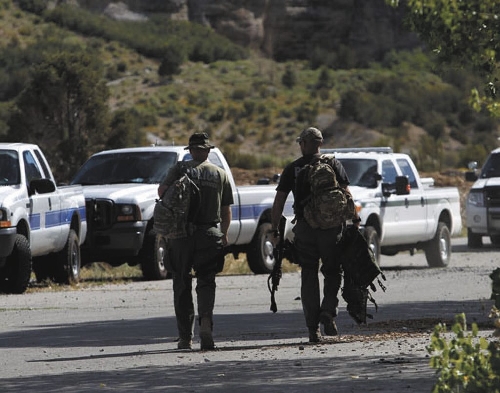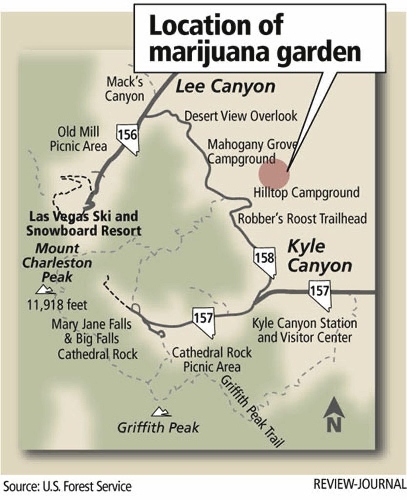Mount Charleston site of latest marijuana farms



At least one industry in Southern Nevada appears to be growing.
Outdoor marijuana farms, once thought to be an ill-suited crop for our dry climate, have been springing up in the mountains surrounding the Las Vegas Valley.
Authorities destroyed a 4-acre pot farm on Wednesday. In the past two months, they have identified six or seven additional farms in Clark County that are slated for removal.
“This totally shocked me,” said Kent Bitsko, director of the federal High Intensity Drug Trafficking Areas program in Nevada.
Bitsko said he always believed Southern Nevada would have few problems with “gardeners” who have invaded the woods of Northern California for decades.
There’s just not enough water here, he said.
“Well, they made a liar out of me, because they found water,” Bitsko said.
On Wednesday morning, officers from several local agencies trekked into the woods of Mount Charleston, in the Deer Creek area between Kyle and Lee canyons, land maintained by the U.S. Forest Service.
Bitsko said 4,000 plants would be cut, bailed and airlifted out of the dense foliage. Then they’ll be loaded onto trailers and eventually destroyed.
The process could continue into today, Bitsko said, mostly because of the size of the operation, but partially because of the officers’ inexperience.
Throughout his 35 years in law enforcement, Bitsko has seen only a handful of pot farms in the Las Vegas area.
“This is a new thing for us, and we’re trying to catch up,” Bitsko said.
Police are at least a few years behind the culprits in Wednesday’s bust.
Evidence at the farm indicated a long residency with several previous harvests, Bitsko said.
As of Wednesday afternoon, no suspects had been arrested or identified.
But hiding from police is one thing. The real question is, how are the growers beating the heat?
Bitsko said growers use a drip irrigation system to pipe water from different water sources, such as a spring, to their plants. Otherwise, the plants couldn’t survive. And unlike most of the valley, Mount Charleston has an ample supply of water, he said.
“They pack a Honda generator out there and set up their pumps. It’s pretty ingenious,” Bitsko said.
Judy Suing, a Forest Service spokeswoman, said the use of pesticides can poison the water and damage the vegetation.
A substantial number of trees were cleared to make room for the pot. In addition, the growers heavily litter their campgrounds and sometimes hunt wildlife out of season.
“It’s a damaging impact on the environment,” Suing said.
Suing said Wednesday’s pot farm was discovered by a Las Vegas police helicopter rescuing a hiker several months ago.
Bitsko said that is how most of the farms have been discovered. Police rescue teams recently received training to help officers spot the farms from the air, he said.
Finding outdoor farms can be more difficult than finding indoor grow houses, which use hydroponic lighting systems and can be identified by infrared scanners.
Officers have to “eyeball” the outdoor plants. This can be dangerous, not just for police, but also for the wayward hiker who stumbles too close.
Some drug traffickers, notably in Northern California, carry weapons and are intent on protecting their investment.
“People say, ‘It’s only marijuana.’ There’s a hell of a lot of money involved in this,” Bitsko said.
The pot is typically planted in the spring and harvested in October, contingent on weather, he said.
Afterward, the pot will be shipped to the East Coast, where a one-pound plant can be sold for upwards of $3,000, he said.
Bitsko said local authorities recently consulted with experts in Sacramento, Calif., on the subject after the farms were discovered.
Although seven farms seems like a high number, Bitsko speculated that as many as 40 farms could be hidden in the Las Vegas Valley, and not just in the mountains.
In April, a large pot farm with a worth in the millions of dollars was discovered in Moapa, where the temperature can get even hotter than in Las Vegas.
Growers were using the Muddy River as their water source, Bitsko said.
“We’re going to get a lot of intelligence. We’re going to learn more,” he said. “And we’ll be better prepared for next year.”
Contact reporter Mike Blasky at
mblasky@reviewjournal.com or 702-383-0283.












